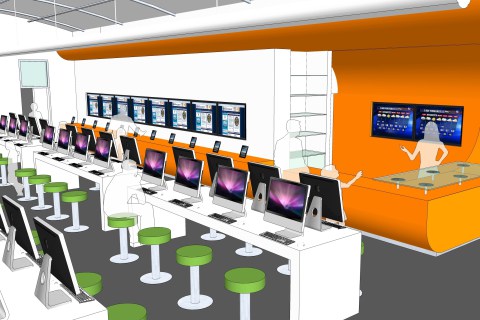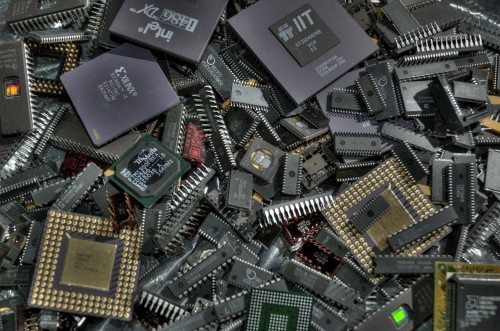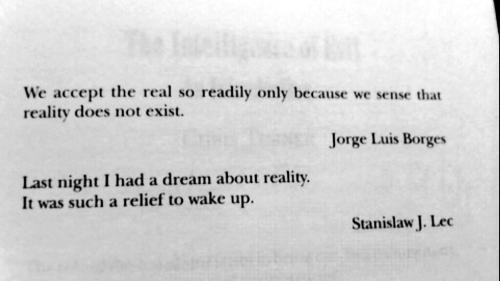A couple of months back, I wrote about an informal meeting of the Cyborgology Crew in which we began to hash out some of the vocabulary issues that currently muddle up theorizing about technology and society. In that post, I interrogated the words “online” and “offline.” This online/offline discussion took up the better part of our day. A second issue also arose, however, and this was one that we never fully resolved. With bellies full of pizza and leg-shaking levels of caffeine, we duked it out over the term “physical co-presence.” Today, I want to put forth our (mostly?) agreed upon critique of the term physical co-presence, and offer an alternative which, on the day of the meeting, I probably articulated poorly. Like the interrogation of online and offline, this is far from a definitive statement. Rather, it is a starting point and a widespread invitation for critique, suggestions, and participation in the construction of a useful theoretical vocabulary. more...

Silicon is a cyborg element. You can find it everywhere, but almost always bonded to something else. Silicon is the second-most abundant element on the planet and yet you have probably never seen it in its pure form. (For the record, it looks kind of like a leftover baked potato wrapped hastily in tin foil.) Entire geographic formations are named after the element, but (and I think this might be a first for naming conventions) those places have largely nothing to do with the extraction or even refinement of that element. Silicon is a prerequisite, a synecdoche for a larger industry that demands we refine and purify this promiscuous metal into a predictable and highly controlled component. True to its namesake, Silicon Valley (not to mention Austin’s lesser-known “Silicon Hills”) is an exercise in refinement. Intricate and eclectic streets are tossed aside in favor of gleaming, modern campuses with strict access control. It is a place where functions are separated so that they may reach the sorts of optimal efficiencies that Le Corbusier promised and Moses tried to deliver. But unlike Moses or Le Corbusier, the planners and corporate patrons of Silicon Valley are making places meant to be freely chosen. more...

Jenny, Whitney, and I were talking on Twitter about Jenny’s recent post on the gender politics of a Microsoft Windows 8 Surface TV advertisement. I want to recap that conversation because it sets up some interesting questions about the relationship between contemporary gender politics and contemporary technology: If Jenny’s post described the gendering of technological devices, how do these attitudes toward technology in turn inform our judgments of human women? How do gendered evaluations of digital media frame our attitudes toward women, especially insofar as women use and are represented in digital media?

The Time article that covers the Bexar County Bibliotech Library in San Antonio, Texas asks a basic question, and it asks it right in the byline. It’s not a unique question; it’s not anywhere close to the first time it’s been asked. It’s a question that captures a lot of anxiety around a particular kind of public space that is, even when it isn’t given a lot of direct attention, pretty firmly embedded in our cultural subconscious.

Last week Twitter introduced an alert system that they described as “ a new feature that brings us one step closer to helping users get important and accurate information during emergencies, natural disasters or when other communications services aren’t accessible.” The alerts show up on users phones as special push notifications and SMS notifications and are marked with an orange bell in your feed. At first blush it seems like a great idea but, given that I’m writing this during yet another government “shutdown”, are governments and NGOs really the only organizations that should get access to this useful service? What can activists do to push back? more...
From an augmented perspective, technologies both reflect and affect social structures and hierarchical relations. It is perhaps no surprise, then, that theorists of science and technology have long recognized how technologies are gendered. This goes beyond probing technologies of female reproduction, or masculine tools of object manipulation. This pervades even those seemingly gender neutral technological objects, and the ways in which we talk about, use, and make sense of them.
Awhile back, I talked about the gendering of Siri. I argued that the female voice, coupled with her designation as a “personal assistant” created an environment ripe for highly sexist/sexualized personification of the iphone application, and iphones themselves. Far from Haraway’s utopic de-categorization, this melding of mechanical and organic solidified gendered meanings and strengthened interactional gender inequalities.
With this understanding, I still couldn’t contain my exasperated eye-roll when, after hooking up television in my home for the first time in almost a decade, I saw this (video after the jump): more...

In a previous post for Cyborgology, I attempted to take what has been called “digital dualism” and repackage it into a slightly new shape—one that would bring into focus what I considered to be the concept’s most significant features. Specifically, I posited that digital dualism should be understood to include—and be limited to—any instance where a speaker establishes a normatively-charged hierarchy of ontological categories, at least one of which is technological. Thus, were a speaker to carve up the world into the “digital” and the “physical” while suggesting the former is somehow ontologically inferior to the latter (or vice versa), she would be instantiating digital dualism, as I defined it.
I next sought to situate digital dualism within a broader set of views that I characterized as “conservative.” Conservatism, I argued, is a cluster of ideologies unified by an effort to justify and further social hierarchy. I argued that ontological hierarchy of the sort that characterizes digital dualism often plays an instrumental role in the conservative project, as it serves to legitimate perceived differences in status. (For more exposition of this point, see my previous Cyborgology post). Indeed, I contend that digital dualism is very often deployed for conservative ends by those who seek to elevate themselves above technophillic masses.
If one accepts these premises, it becomes possible to formulate generalized strategies for critique, beginning with contestations of (conservative) digital dualism and then abstracting to arguments that might be directed against other conservative ideologies that rest upon hierarchical ontologies.

“In some circles, being inaccessible is a status symbol”
“the intention behind the looking matters the most”
“clothing that does not move, rigid materials that force a body into an idealized appearance”
“romance was alive and well in the Instagram iteration of their marriage”
“Guys who try to hit on you by asking if you want to try on their Google Glass”

Hello, I’m Jony Ive, Senior Vice President of Design at Apple, and I want to tell you about a new product that you will absolutely love. It has been crafted with pain-staking attention to detail. Absolutely every aspect of this phone has been given the kind of care that you have come to expect from an Apple product. The seamless integration of hardware and software produces a product that, once you use it, will make you wonder how you lived your life without it. Today I’m thrilled to announce our best iPhone yet. We’ve crafted a phone that works and smells just the way you expect it to and we’re calling it iPhone Pumpkin Spice. more...



